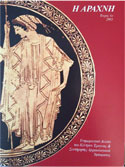Iconography
The term iconography includes all archaeological finds with iconographic representations such as wall paintings, sculpture, vase painting, mosaics, figurative or other representations on coins etc. Iconography is one of the basic sources of information on ancient textiles and their production, and it provides us with several kinds of evidence related both to techniques and to the social aspect of textiles.
Iconography is the source of our knowledge on ancient fashion and garments as well as their diachronic changes. For instance, the garments worn by Minoan women are very different than those worn by Athenian women of the 5th century B.C. By combining evidence from iconography with information from other sources (i.e. ancient texts) it is possible to study ancient textiles in details such as the several different kinds of fabrics, their quantity and the tailoring necessary for the manufacture of each type of garment.
We can also find information regarding the colours and the techniques of embellishment of the fabrics. With regard to colours, in particular, ancient wall paintings depicting dressed individuals as well as sculptures preserving traces of colours, and white ground vase paintings offer a wealth of information.
With regard to the embellishment of textiles, artistic representations inform us on the variety of decorative motifs, which were either geometric designs or figurative ones, as well as for the exact spots of the garments where those motifs appeared. For example, in the Classical period the selvedges were often decorated with geometric patterns. Moreover, we can spot other decorative elements such as fringes, permanent pleats and applied metal decorations.Quite often we can discern between thick and heavy textiles and fine and transparent ones, which allow the human body to be seen. Transparent garments are depicted in the wall paintings of Akrotiri, Thera, as well as on several vase paintings of the Classical period.
Iconography also allows an understanding of the alternative uses of textiles, beyond clothing. Textiles could be found everywhere and were manufactured in several different forms to serve various needs. They were made into containers, beddings, carpets, tents and sails etc.
At the same time, iconography also informs us on technical issues of the textile industry. For example, the activity of spinning was a favourite theme to vase painters of the 1st millennium B.C., and even more for those of the Classical period. Other stages or techniques of the production, such as weaving on the warp-weighted loom, the techniques of sprang or weaving on a small portable loom, were less often depicted in ancient art. In some occasions, artistic representations are complex scenes of textile production with women engaging in different stages of cloth manufacture.
It should be noted that in some cases the study and interpretation of iconography is not as straight-forward as we would wish, and some iconographic elements cannot be readily recognized, as they depend on artistic conventions of the particular period under study. For example, certain motifs on the surface of garments might be hard to understand, or we might not be able to recognize a specific technique of weaving in a depicted textile, as is the case with grids of diagonal lines. Such patterns could indicate either twill or check weaves.
In any case, the validity of our hypotheses concerning ancient iconography can be checked against information derived from ancient written texts.


